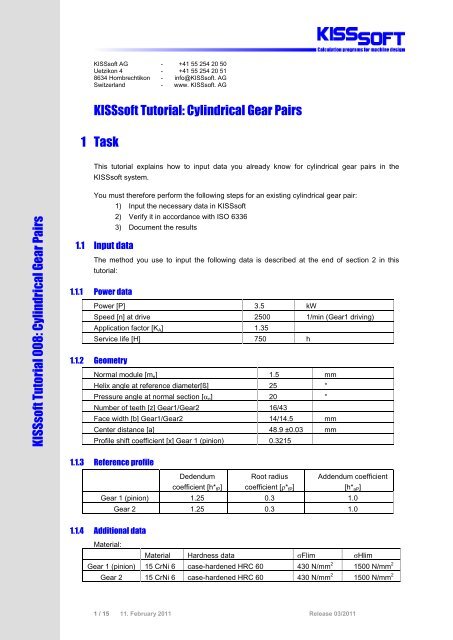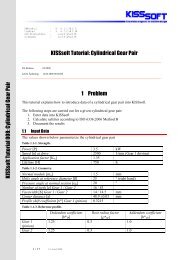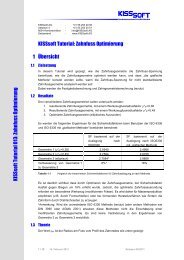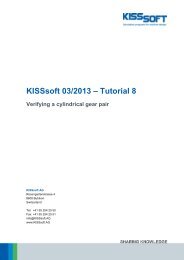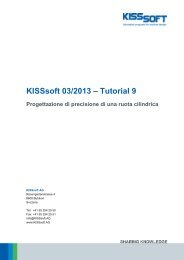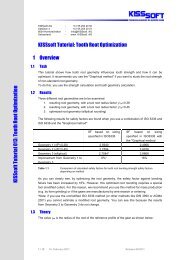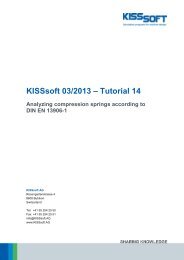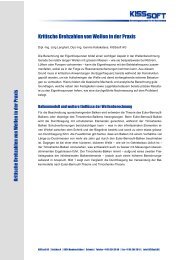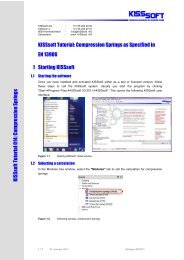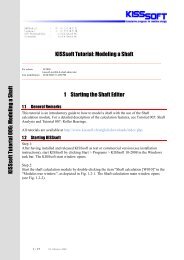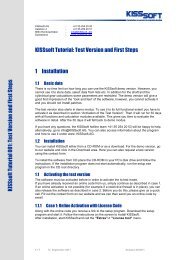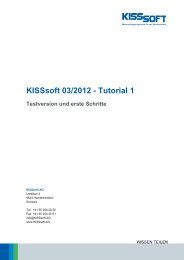KISSsoft Tutorial: Cylindrical Gear Pairs 1 Task ... - KISSsoft AG
KISSsoft Tutorial: Cylindrical Gear Pairs 1 Task ... - KISSsoft AG
KISSsoft Tutorial: Cylindrical Gear Pairs 1 Task ... - KISSsoft AG
You also want an ePaper? Increase the reach of your titles
YUMPU automatically turns print PDFs into web optimized ePapers that Google loves.
<strong>KISSsoft</strong> <strong>AG</strong> - +41 55 254 20 50<br />
Uetzikon 4 - +41 55 254 20 51<br />
8634 Hombrechtikon - info@<strong>KISSsoft</strong>. <strong>AG</strong><br />
Switzerland - www. <strong>KISSsoft</strong>. <strong>AG</strong><br />
<strong>KISSsoft</strong> <strong>Tutorial</strong>: <strong>Cylindrical</strong> <strong>Gear</strong> <strong>Pairs</strong><br />
1 <strong>Task</strong><br />
This tutorial explains how to input data you already know for cylindrical gear pairs in the<br />
<strong>KISSsoft</strong> system.<br />
<strong>KISSsoft</strong> <strong>Tutorial</strong> 008: <strong>Cylindrical</strong> <strong>Gear</strong> <strong>Pairs</strong><br />
You must therefore perform the following steps for an existing cylindrical gear pair:<br />
1) Input the necessary data in <strong>KISSsoft</strong><br />
2) Verify it in accordance with ISO 6336<br />
3) Document the results<br />
1.1 Input data<br />
The method you use to input the following data is described at the end of section 2 in this<br />
tutorial:<br />
1.1.1 Power data<br />
Power [P] 3.5 kW<br />
Speed [n] at drive 2500 1/min (<strong>Gear</strong>1 driving)<br />
Application factor [K A ] 1.35<br />
Service life [H] 750 h<br />
1.1.2 Geometry<br />
Normal module [m n ] 1.5 mm<br />
Helix angle at reference diameter[ß] 25 °<br />
Pressure angle at normal section [ n ] 20 °<br />
Number of teeth [z] <strong>Gear</strong>1/<strong>Gear</strong>2 16/43<br />
Face width [b] <strong>Gear</strong>1/<strong>Gear</strong>2 14/14.5 mm<br />
Center distance [a] 48.9 ±0.03 mm<br />
Profile shift coefficient [x] <strong>Gear</strong> 1 (pinion) 0.3215<br />
1.1.3 Reference profile<br />
Dedendum<br />
coefficient [h* fP ]<br />
Root radius<br />
coefficient [* fP ]<br />
Addendum coefficient<br />
[h* aP ]<br />
<strong>Gear</strong> 1 (pinion) 1.25 0.3 1.0<br />
<strong>Gear</strong> 2 1.25 0.3 1.0<br />
1.1.4 Additional data<br />
Material:<br />
Material Hardness data Flim Hlim<br />
<strong>Gear</strong> 1 (pinion) 15 CrNi 6 case-hardened HRC 60 430 N/mm 2 1500 N/mm 2<br />
<strong>Gear</strong> 2 15 CrNi 6 case-hardened HRC 60 430 N/mm 2 1500 N/mm 2<br />
1 / 15 11. February 2011 Release 03/2011
Lubrication:<br />
Grease lubrication Microlube GB 00 80 °C<br />
Base tangent length allowances<br />
No. of teeth Max. base tangent length Min. base tangent<br />
spanned [k] [Wkmax]<br />
length [Wkmin]<br />
<strong>Gear</strong> 1 (pinion) 3 11.782 mm 11.758 mm<br />
<strong>Gear</strong> 2 6 25.214 mm 25.183 mm<br />
Quality [Q] (ISO 6363) 8/8<br />
Lead correction factor end relief<br />
Contact pattern<br />
not verified or inappropriate<br />
Type of pinion shaft<br />
Figure 1.1<br />
Load case for the pinion shaft<br />
ISO 6336 Picture 13a; l = 53 mm; s = 5.9 mm; dsh = 14 mm<br />
2 Solution<br />
2.1 Starting the software<br />
Once you have installed and activated <strong>KISSsoft</strong> either as a test or licensed version, follow<br />
these steps to call the <strong>KISSsoft</strong> system. Usually you start the program by clicking<br />
"StartProgram Files<strong>KISSsoft</strong> 03-2011<strong>KISSsoft</strong>". This opens the following <strong>KISSsoft</strong> user<br />
interface:<br />
Figure 2.1<br />
Starting <strong>KISSsoft</strong>, initial window<br />
2.2 Selecting a calculation<br />
In the Modules tree window, select the "Modules" tab to call the calculation for cylindrical gear<br />
pairs:<br />
2 / 15 11. February 2011 Release 03/2011
Figure 2.2<br />
Calling cylindrical gear calculation<br />
The <strong>KISSsoft</strong> input window then opens:<br />
Figure 2.3<br />
Input window: <strong>KISSsoft</strong> <strong>Cylindrical</strong> gear calculation<br />
The following sections describe how to input parameters for the gear pair.<br />
2.3 <strong>Gear</strong> Pair Geometry<br />
In the "Basic data" tab, "Geometry" group, input the normal module (1.5 mm), pressure angle<br />
(20°), helix angle (25°), center distance (48.9 mm), number of teeth (16/43), tooth widths<br />
(14/14.5 mm), profile shift coefficient (0.3215/. ..) and the quality (8/8). You cannot input a value<br />
for the profile shift of gear 2 directly because this value is calculated from the center distance<br />
and profile shift of the first gear.<br />
However, you can click the Sizing button to size the value to match your requirements.<br />
You can set the quality to suit you, no matter which calculation method is in use.<br />
3 / 15 11. February 2011 Release 03/2011
Figure 2.4<br />
Module-specific settings. Quality does not depend on calculation method<br />
Figure 2.5:<br />
Input window – "Basic data" tab, "Geometry" group<br />
Click the Convert button to the right of the input fields to enter additional data for each<br />
field, or to input other data for these particular values. If you need to input an angle, right-click<br />
in the input field to open another window in which you can enter the angle, minutes and<br />
seconds:<br />
Figure 2.6<br />
Additional entries, normal module, angle details<br />
2.4 Defining power data and calculation method<br />
In the "Strength" group, in the "Basic data" tab input window, you can now define the<br />
kinematics, the required service life (750 h) and the application factor (1.35). In this example,<br />
the torque is defined by inputting the power (3.5 kW) and speed (2500 1/min). However, in a<br />
different example, if you want to input the torque and calculate the power, simply set the<br />
"Selection" button to the right of the input field from torque to power. Under Details you can<br />
now input even more parameters about strength.<br />
It is also important that you set the reference gear correctly (first gear - <strong>Gear</strong> 1) for the load.<br />
Select the calculation method in the drop-down list you see on the right. In this case, you must<br />
also switch to ISO 6363:2006 Method B.<br />
4 / 15 11. February 2011 Release 03/2011
Figure 2.7 Input window – "Basic data" tab, Strength group<br />
You can input face load factor K Hß either directly (to do this, set the flag in the checkbox) or<br />
define it by clicking the Plus button next to the input field .<br />
Figure 2.8<br />
Defining the face load factor<br />
To calculate the load coefficients, you must enter:<br />
- The lead correction (in this case "End relief" Figure 2.9).<br />
- Possible shaft configurations. To do this, click the Info button to the right of the<br />
"Type of pinion shaft" field in the "Info window". See the selection on the right-hand<br />
side of the next figure. This example corresponds to Figure A in Figure 2.9. You can<br />
then input the distances l and s as soon as the flag is set in the checkbox behind the<br />
corresponding input fields.<br />
- You must also select the Position of contact pattern, which is not verified, from the<br />
appropriate drop-down list.<br />
Figure 2.9<br />
Defining the face load factor<br />
5 / 15 11. February 2011 Release 03/2011
Note:<br />
You need the shaft configuration to calculate face load factor K Hß . ISO 6336 (or DIN 3990)<br />
provides 5 different configurations from which you can select the one you require. These<br />
examples are listed A to E in the previous figure.<br />
Face load factor K Hß shows the non-linear distribution of the load across the face width. You<br />
can request separate instructions about this from <strong>KISSsoft</strong> <strong>AG</strong>: see document: "kisssoft-anl-<br />
002-D-Eingabe-des-Breitenlastfaktors-KHß.doc".<br />
2.5 Material and lubrication<br />
In the "Basic data", "Material and lubrication" group, you will see drop-down lists from which<br />
you can select the materials used to form the gears. 15 Cr Ni 6, case-carburized steel is used<br />
in this example.<br />
You can also select the individual lubricant as well as the lubrication type.<br />
Figure 2.10<br />
Input window – "Basic data" tab, Material and lubrication group<br />
Click the plus button<br />
on the far right to define the lubricant temperature.<br />
2.6 Reference profile<br />
In the "Reference profile" tab you can now input further data, such as the reference profile,<br />
the dedendum coefficient, the root radius factor and the addendum coefficient for <strong>Gear</strong> 1 and<br />
<strong>Gear</strong> 2.<br />
Figure 2.11<br />
Input window – "Reference profile" tab<br />
2.7 Tolerances<br />
Define the tooth thickness deviation in the "Tolerances" tab. In a verification example, it is<br />
often the case that only the effective tolerances of base tangent length and the number of teeth<br />
spanned are specified. If you input these values, the <strong>KISSsoft</strong> system will then calculate the<br />
correct tooth thickness tolerances for the tooth form.<br />
In this case, you can also input the center distance tolerances either by selecting them from the<br />
drop-down list or by inputting your own values as shown in the example.<br />
6 / 15 11. February 2011 Release 03/2011
Figure 2.12<br />
Input window – "Tolerances" tab<br />
To input the base tangent lengths, click the "Tolerances" tab, "Deviation" group, and then click<br />
the Sizing button<br />
next to the tooth thickness deviation input window (middle markings).<br />
Figure 2.13<br />
Calculating the base tangent lengths<br />
You can now input the number of teeth spanned and the base tangent length (min/max). Then<br />
click Calculate . Then click "Accept" to transfer the values to the main screen.<br />
Warning: you cannot input a deviation until profile shifts have been determined for both gears.<br />
Otherwise you will receive incorrect values and you must repeat the sizing process.<br />
Note: You can change the Number of teeth spanned between steps 2 and 3. To do this, set the<br />
flag in the "checkbox" next to the "Number of teeth spanned" field in the input window: select<br />
the "Tolerances" tab, "Settings" group, and then change the Number of teeth spanned either in<br />
the "Settings" group or in the calculation screen.<br />
Figure 2.14<br />
Input window – "Tolerances" tab, "Settings" group<br />
2.8 Lubrication<br />
The input window for the "Basic data" tab, "Material and lubrication" group, is only designed to<br />
hold the input value for lubricant temperature for the various types of lubricant that can be<br />
7 / 15 11. February 2011 Release 03/2011
used. You can select other lubrication types and grease types in the appropriate drop-down list<br />
when you input the temperature as a numerical value.<br />
The "Lubricant temperature" input field for oil or grease lubrication defines the basic<br />
temperature of the gear body. For this reason, the "Lubricant temperature" is also important<br />
for calculating effective lubricant viscosity. However, the "Ambient temperature" has no effect<br />
on the calculation (see also 2.5 Material and lubrication).<br />
The "Ambient temperature" field only defines the base temperature during a dry run. In this<br />
case, the temperature of the gear body does influence the calculation.<br />
Exceptions:<br />
- Worm gears: the "Ambient temperature" is an input value used to calculate the temperature<br />
safety coefficient.<br />
- Plastic gears: as the strength values of plastic gears depend greatly on the temperature of the<br />
gear body you must input the corresponding temperatures here.<br />
Figure 2.15<br />
Inputting the temperature for a dry run<br />
Figure 2.16<br />
Inputting the temperature for grease lubrication<br />
2.9 Calculate<br />
Click in the tool bar or press "F5" to calculate the strength results. As the proof of the<br />
contact pattern is missing, this message appears to tell you the K Hß value is too high.<br />
Figure 2.17<br />
Information window after "Calculation"<br />
This means that the calculation for the value K Hß was performed with an unrealistic contact<br />
pattern. When you test the contact pattern in the workshop, you can see whether this<br />
assumption was conservative or realistic.<br />
If you have worked through this tutorial correctly, the highlighted strength values should agree<br />
with Figure 2.18:<br />
8 / 15 11. February 2011 Release 03/2011
Figure 2.18<br />
End results for tutorial<br />
9 / 15 11. February 2011 Release 03/2011
2.10 Report<br />
<strong>KISSsoft</strong> - Release 03-2011<br />
<strong>KISSsoft</strong>-Entwicklungs-Version <strong>KISSsoft</strong> <strong>AG</strong> CH-8634 HOMBRECHTIKON<br />
File<br />
Name : <strong>Tutorial</strong>-008_ISO<br />
Description: <strong>KISSsoft</strong> example<br />
Changed by : ho on: 11.02.2011 at: 08:42:49<br />
Important hint: At least one warning has occurred during the calculation:<br />
1-> Indication:<br />
With the setting 'Position of the contact pattern: unfavorable'<br />
unrealistic high face load coefficient KHb is given for gears with tooth trace modifications.<br />
CALCULATION OF A HELICAL GEAR PAIR<br />
Drawing or article number:<br />
<strong>Gear</strong> 1: 0.000.0<br />
<strong>Gear</strong> 2: 0.000.0<br />
Calculation method ISO 6336:2006 Method B<br />
------- GEAR 1 -------- GEAR 2 --<br />
Power (kW) [P] 3.500<br />
Speed (1/min) [n] 2500.0 930.2<br />
Torque (Nm) [T] 13.4 35.9<br />
Application factor [KA] 1.35<br />
Required service life [H] 750.00<br />
<strong>Gear</strong> driving (+) / driven (-) + -<br />
1. TOOTH GEOMETRY AND MATERIAL<br />
(Geometry calculation according ISO 21771)<br />
------- GEAR 1 -------- GEAR 2 --<br />
Center distance (mm) [a] 48.900<br />
Centre distance allowances (mm) [Aa.e/i] 0.030 / -0.030<br />
Normal module (mm) [mn] 1.5000<br />
Pressure angle at normal section (°) [alfn] 20.0000<br />
Helix angle at reference circle (°) [beta] 25.0000<br />
Number of teeth [z] 16 43<br />
Facewidth (mm) [b] 14.00 14.50<br />
Hand of gear right left<br />
Accuracy grade [Q-ISO1328] 8 8<br />
Inner diameter (mm) [di] 0.00 0.00<br />
Inner diameter of gear rim (mm) [dbi] 0.00 0.00<br />
Material<br />
<strong>Gear</strong> 1:<br />
<strong>Gear</strong> 2:<br />
15 CrNi 6, Case-carburized steel, case-hardened<br />
ISO 6336-5 Figure 9/10 (MQ), core strength >=25HRC Jominy J=12mm=25HRC Jominy J=12mm=0.85)<br />
Fatigue strength. tooth root stress (N/mm²)<br />
[sigFlim] 430.00 430.00<br />
Fatigue strength for Hertzian pressure (N/mm²)<br />
[sigHlim] 1500.00 1500.00<br />
Tensile strength (N/mm²) [Rm] 1000.00 1000.00<br />
Yield point (N/mm²) [Rp] 685.00 685.00<br />
Young's modulus (N/mm²) [E] 206000 206000<br />
Poisson's ratio [ny] 0.300 0.300<br />
Average roughness, Ra, tooth flank (µm) [RAH] 0.60 0.60<br />
Mean roughness height, Rz, flank (µm) [RZH] 4.80 4.80<br />
Mean roughness height, Rz, root (µm) [RZF] 20.00 20.00<br />
Tool or reference profile of gear 1 :<br />
Reference profile 1.25 / 0.30 / 1.0 ISO 53.2 Profil B<br />
Addendum coefficient [haP*] 1.000<br />
Dedendum coefficient [hfP*] 1.250<br />
Tip radius factor [rhoaP*] 0.000<br />
Root radius factor [rhofP*] 0.300<br />
Tip form height coefficient [hFaP*] 0.000<br />
Protuberance height factor [hprP*] 0.000<br />
Protuberance angle [alfprP] 0.000<br />
Ramp angle [alfKP] 0.000<br />
not topping<br />
Tool or reference profile of gear 2 :<br />
Reference profile 1.25 / 0.30 / 1.0 ISO 53.2 Profil B<br />
Addendum coefficient [haP*] 1.000<br />
Dedendum coefficient [hfP*] 1.250<br />
Tip radius factor [rhoaP*] 0.000<br />
Root radius factor [rhofP*] 0.300<br />
Tip form height coefficient [hFaP*] 0.000<br />
10 / 15 11. February 2011 Release 03/2011
Protuberance height factor [hprP*] 0.000<br />
Protuberance angle [alfprP] 0.000<br />
Ramp angle [alfKP] 0.000<br />
not topping<br />
Summary of reference profile gears:<br />
Dedendum reference profile (module) [hfP*] 1.250 1.250<br />
Tooth root radius Refer. profile (module)<br />
[rofP*] 0.300 0.300<br />
Addendum Reference profile (module) [haP*] 1.000 1.000<br />
Protuberance height (module) [hprP*] 0.000 0.000<br />
Protuberance angle (°) [alfprP] 0.000 0.000<br />
Buckling root flank height (module) [hFaP*] 0.000 0.000<br />
Buckling root flank angle (°) [alfKP] 0.000 0.000<br />
Type of profile modification:<br />
none (only running-in)<br />
Tip relief (µm) [Ca] 2.00 2.00<br />
Lubrication type<br />
Grease lubrication<br />
Type of grease Grease: Microlube GB 00<br />
Lubricant base<br />
Mineral-oil base<br />
Kinem. viscosity base oil at 40 °C (mm²/s) [nu40] 700.00<br />
Kinem. viscosity base oil at 100 °C (mm²/s) [nu100] 35.00<br />
FZG-Test A/8.3/90 step [FZGtestA] 12<br />
Specific density at 15 °C (kg/dm³) [roOil] 0.900<br />
Grease temperature (°C) [TS] 80.000<br />
------- GEAR 1 -------- GEAR 2 --<br />
Overall transmission ratio [itot] -2.688<br />
<strong>Gear</strong> ratio [u] 2.688<br />
Transverse module (mm) [mt] 1.655<br />
Pressure angle at Pitch circle (°) [alft] 21.880<br />
Working transverse pressure angle (°) [alfwt] 22.100<br />
[alfwt.e/i] 22.186 / 22.013<br />
Working pressure angle at normal section (°) [alfwn] 20.199<br />
Helix angle at operating pitch circle (°)<br />
[betaw] 25.034<br />
Base helix angle (°) [betab] 23.399<br />
Reference centre distance (mm) [ad] 48.824<br />
Sum of profile shift coefficients [Summexi] 0.0506<br />
Profile shift coefficient [x] 0.3215 -0.2709<br />
Tooth thickness (Arc) (module) [sn*] 1.8048 1.3736<br />
Tip alteration (mm) [k*mn] 0.000 0.000<br />
Reference diameter (mm) [d] 26.481 71.168<br />
Base diameter (mm) [db] 24.573 66.041<br />
Tip diameter (mm) [da] 30.446 73.355<br />
(mm) [da.e/i] 30.446 / 30.436 73.355 / 73.345<br />
Tip diameter allowances (mm) [Ada.e/i] 0.000 / -0.010 0.000 / -0.010<br />
Tip chamfer / tip rounding (mm) [hK] 0.000 0.000<br />
Tip form diameter (mm) [dFa] 30.446 73.355<br />
(mm) [dFa.e/i] 30.446 / 30.436 73.355 / 73.345<br />
Operating pitch diameter (mm) [dw] 26.522 71.278<br />
(mm) [dw.e/i] 26.538 / 26.506 71.322 / 71.234<br />
Root diameter (mm) [df] 23.696 66.605<br />
Generating Profile shift coefficient [xE.e/i] 0.2601 / 0.2367 -0.3275 / -0.3577<br />
Manufactured root diameter with xE (mm) [df.e/i] 23.511 / 23.441 66.436 / 66.345<br />
Theoretical tip clearance (mm) [c] 0.375 0.375<br />
Effective tip clearance (mm) [c.e/i] 0.540 / 0.429 0.537 / 0.437<br />
Active root diameter (mm) [dNf] 25.050 68.670<br />
(mm) [dNf.e/i] 25.086 / 25.020 68.719 / 68.627<br />
Root form diameter (mm) [dFf] 24.894 67.921<br />
(mm) [dFf.e/i] 24.820 / 24.794 67.816 / 67.761<br />
Reserve (dNf-dFf)/2 (mm) [cF.e/i] 0.146 / 0.100 0.479 / 0.405<br />
Addendum (mm) [ha = mn * (haP*+x)] 1.982 1.094<br />
(mm) [ha.e/i] 1.982 / 1.977 1.094 / 1.089<br />
Dedendum (mm) [hf = mn * (hfP*-x)] 1.393 2.281<br />
(mm) [hf.e/i] 1.485 / 1.520 2.366 / 2.411<br />
Roll angle at dFa (°) [xsi_dFa.e/i] 41.909 / 41.870 27.702 / 27.682<br />
Roll angle to dNa (°) [xsi_dNa.e/i] 41.909 / 41.870 27.702 / 27.682<br />
Roll angle to dNf (°) [xsi_dNf.e/i] 11.766 / 10.969 16.480 / 16.189<br />
Roll angle at dFf (°) [xsi_dFf.e/i] 8.135 / 7.696 13.371 / 13.160<br />
Tooth height (mm) [H] 3.375 3.375<br />
Virtual gear no. of teeth [zn] 20.960 56.329<br />
Normal Tooth thickness at Tip cyl. (mm) [san] 0.874 1.225<br />
(mm) [san.e/i] 0.806 / 0.771 1.166 / 1.127<br />
Normal space width at tip cylinder (mm) [efn] 0.000 1.352<br />
(mm) [efn.e/i] 0.000 / 0.000 1.388 / 1.409<br />
Max. sliding velocity at tip (m/s) [vga] 1.436 0.919<br />
Specific sliding at the tip [zetaa] 0.610 0.591<br />
Specific sliding at the root [zetaf] -1.443 -1.567<br />
Sliding factor on tip [Kga] 0.414 0.265<br />
Sliding factor on root [Kgf] -0.265 -0.414<br />
Pitch on reference circle (mm) [pt] 5.200<br />
Base pitch (mm) [pbt] 4.825<br />
Transverse pitch on contact-path (mm) [pet] 4.825<br />
Lead height (mm) [pz] 178.408 479.470<br />
Axial pitch (mm) [px] 11.150<br />
Length of path of contact (mm) [ga, e/i] 6.555 ( 6.635 / 6.456)<br />
Length T1-A, T2-A (mm) [T1A, T2A] 2.432( 2.352/ 2.523) 15.965(15.965/15.954)<br />
Length T1-B (mm) [T1B, T2B] 4.162( 4.162/ 4.154) 14.235(14.155/14.323)<br />
Length T1-C (mm) [T1C, T2C] 4.989( 4.967/ 5.011) 13.408(13.350/13.466)<br />
11 / 15 11. February 2011 Release 03/2011
Length T1-D (mm) [T1D, T2D] 7.257( 7.177/ 7.348) 11.140(11.140/11.129)<br />
Length T1-E (mm) [T1E, T2E] 8.987( 8.987/ 8.979) 9.410( 9.330/ 9.498)<br />
Length T1-T2 (mm) [T1T2] 18.397 (18.317 / 18.477)<br />
Diameter of single contact point B (mm)<br />
[d-B] 25.945(25.945/25.940) 71.916(71.853/71.986)<br />
Diameter of single contact point D (mm)<br />
[d-D] 28.540(28.459/28.633) 69.698(69.698/69.691)<br />
Addendum contact ratio [eps] 0.829( 0.833/ 0.822) 0.530( 0.542/ 0.516)<br />
Minimal length of contact line (mm) [Lmin] 19.611<br />
Transverse contact ratio [eps_a] 1.359<br />
Transverse contact ratio with allowances [eps_a.e/m/i] 1.375 / 1.357 / 1.338<br />
Overlap ratio [eps_b] 1.256<br />
Total contact ratio [eps_g] 2.614<br />
Total contact ratio with allowances [eps_g.e/m/i] 2.631 / 2.612 / 2.594<br />
2. FACTORS OF GENERAL INFLUENCE<br />
------- GEAR 1 -------- GEAR 2 --<br />
Nominal circum. force at pitch circle (N)<br />
[Ft] 1009.7<br />
Axial force (N) [Fa] 470.8<br />
Radial force (N) [Fr] 405.5<br />
Normal force (N) [Fnorm] 1185.6<br />
Tangent.load at p.c.d.per mm (N/mm) (N/mm)<br />
[w] 72.12<br />
Only as information: Forces at operating pitch circle:<br />
Nominal circumferential force (N) [Ftw] 1008.1<br />
Axial force (N) [Faw] 470.8<br />
Radial force (N) [Frw] 409.4<br />
Circumferential speed pitch d.. (m/sec) [v] 3.47<br />
Running-in value (µm) [yp] 1.1<br />
Running-in value (µm) [yf] 1.0<br />
Correction coefficient [CM] 0.800<br />
<strong>Gear</strong> body coefficient [CR] 1.000<br />
Reference profile coefficient [CBS] 0.975<br />
Material coefficient [E/Est] 1.000<br />
Singular tooth stiffness (N/mm/µm) [c'] 12.156<br />
Meshing stiffness (N/mm/µm) [cgalf] 15.426<br />
Meshing stiffness (N/mm/µm) [cgbet] 13.112<br />
Reduced mass (kg/mm) [mRed] 0.00235<br />
Resonance speed (min-1) [nE1] 48315<br />
Nominal speed (-) [N] 0.052<br />
Subcritical range<br />
Running-in value (µm) [ya] 1.1<br />
Bearing distance l of pinion shaft (mm) [l] 53.000<br />
Distance s of pinion shaft (mm) [s] 5.900<br />
Outside diameter of pinion shaft (mm) [dsh] 14.000<br />
load according ISO 6336/1 Diagram 16 [-] 0<br />
0:a), 1:b), 2:c), 3:d), 4:e)<br />
coefficient K' following ISO 6336/1 Diagram 13<br />
[K'] 0.80<br />
Without support effect<br />
Tooth trace deviation (active) (µm) [Fby] 15.11<br />
from deformation of shaft (µm) [fsh*B1] 2.56<br />
Tooth trace: with end relief<br />
Position of Contact pattern: not verified or inappropriate<br />
from production tolerances (µm) [fma*B2] 14.36<br />
Tooth trace deviation, theoretical (µm) [Fbx] 17.77<br />
Running-in value (µm) [yb] 2.7<br />
Dynamic factor [KV] 1.051<br />
Width factor - flank [KHb] 1.968<br />
- Tooth root [KFb] 1.676<br />
- Scuffing [KBb] 1.968<br />
Transverse coefficient - flank [KHa] 1.341<br />
- Tooth root [KFa] 1.341<br />
- Scuffing [KBa] 1.341<br />
Helix angle coefficient scuffing [Kbg] 1.242<br />
Number of load changes (in mio.) [NL] 112.500 41.860<br />
3. TOOTH ROOT STRENGTH<br />
------- GEAR 1 -------- GEAR 2 --<br />
Calculation of Tooth form coefficients according method: B<br />
(Calculate tooth form factor YF with manufacturing addendum mod. xE.e)<br />
Tooth form factor [YF] 1.37 1.67<br />
Stress correction factor [YS] 2.15 1.84<br />
Working angle (°) [alfen] 21.64 18.97<br />
Bending lever arm (mm) [hF] 1.52 1.84<br />
Tooth thickness at root (mm) [sFn] 3.14 3.15<br />
Tooth root radius (mm) [roF] 0.65 0.82<br />
(hF* = 1.012/1.225 sFn* = 2.093/2.102 roF* = 0.431/0.545 dsFn = 24.00/67.03 alfsFn =<br />
30.00/30.00)<br />
Contact ratio factor [Yeps] 1.000<br />
Helix angle factor [Ybet] 0.792<br />
12 / 15 11. February 2011 Release 03/2011
Deep tooth factor [YDT] 1.000<br />
<strong>Gear</strong> rim factor [YB] 1.000 1.000<br />
Effective facewidth (mm) [beff] 14.00 14.50<br />
Nominal shear stress at tooth root (N/mm²)<br />
[sigF0] 112.30 113.33<br />
Tooth root stress (N/mm²) [sigF] 358.07 361.35<br />
Permissible bending stress at root of Test-gear<br />
Support factor [YdrelT] 0.999 0.994<br />
Surface factor [YRrelT] 0.957 0.957<br />
Size coefficient (Tooth root) [YX] 1.000 1.000<br />
Finite life factor [YNT] 0.930 0.949<br />
[YdrelT*YRrelT*YX*YNT] 0.889 0.902<br />
Alternating bending coefficient [YM] 1.000 1.000<br />
Stress correction factor [Yst] 2.00<br />
Limit strength tooth root (N/mm²) [sigFG] 764.63 776.06<br />
Permissible tooth root stress (N/mm²)<br />
[sigFP=sigFG/SFmin] 588.17 596.97<br />
Required safety [SFmin] 1.30 1.30<br />
Safety for Tooth root stress [SF=sigFG/sigF] 2.14 2.15<br />
Transmittable power (kW) [kWRating] 5.75 5.78<br />
4. SAFETY <strong>AG</strong>AINST PITTING (TOOTH FLANK)<br />
------- GEAR 1 -------- GEAR 2 --<br />
Zone factor [ZH] 2.291<br />
Elasticity coefficient (N^.5/mm) [ZE] 189.812<br />
Contact ratio factor [Zeps] 0.858<br />
Helix angle factor [Zbet] 0.952<br />
Effective facewidth (mm) [beff] 14.00<br />
Nominal flank pressure (N/mm²) [sigH0] 686.65<br />
Surface pressure at Operating pitch circle (N/mm²)<br />
[sigHw] 1328.53<br />
Single tooth contact factor [ZB,ZD] 1.00 1.00<br />
Flank pressure (N/mm²) [sigH] 1328.53 1328.53<br />
Lubrication factor [ZL] 1.096 1.093<br />
Speed factor [ZV] 0.974 0.975<br />
Roughness factor [ZR] 0.937 0.939<br />
Material mating factor [ZW] 1.000 1.000<br />
Finite life factor [ZNT] 0.975 1.014<br />
[ZL*ZV*ZR*ZNT] 0.976 1.014<br />
Small amount of pitting permissible (0=no, 1=yes) 0 0<br />
Size coefficient (flank) [ZX] 1.000 1.000<br />
Limit strength pitting (N/mm²) [sigHG] 1464.48 1521.64<br />
Permissible surface pressure (N/mm²) [sigHP=sigHG/SHmin] 1541.56 1601.73<br />
Safety for surface pressure at operating pitch circle<br />
[SHw] 1.10 1.15<br />
Required safety [SHmin] 0.95 0.95<br />
Transmittable power (kW) [kWRating] 4.71 5.09<br />
Safety for stress at single tooth contact<br />
[SHBD=sigHG/sigH] 1.10 1.15<br />
(Safety regarding nominal torque) [(SHBD)^2] 1.22 1.31<br />
5. STRENGTH <strong>AG</strong>AINST SCUFFING<br />
Calculation method according to ISO/TR 13989<br />
The calculation of load capacity for scuffing does not cover grease.<br />
The FZG-Test stage [FZGtestA] is only estimated for grease.<br />
The calculation can only serve as a rough guide.!<br />
Lubrication coefficient (for lubrication type)<br />
[XS] 1.200<br />
Lubricant factor [XL] 1.000<br />
Multiple meshing factor [Xmp] 1.0<br />
Relative structure coefficient (Scoring) [XWrelT] 1.000<br />
Thermal contact factor (N/mm/s^.5/K) [BM] 13.795 13.795<br />
Relevant tip relief (µm) [Ca] 2.00 2.00<br />
Optimal tip relief (µm) [Ceff] 6.31<br />
Effective facewidth (mm) [beff] 14.000<br />
Applicable circumferential force/tooth width (N/mm)<br />
[wBt] 269.984<br />
(Kbg = 1.242, wBt*Kbg = 335.345)<br />
Flash factor (°K*N^-.75*s^.5*m^-.5*mm) [XM] 1.581<br />
Pressure angle factor (eps1:<br />
0.990, eps2: 0.829) [Xalfbet] 0.530<br />
Flash temperature-criteria<br />
Tooth mass temperature (°C) [theMi] 93.52<br />
theM = theoil + XS*0.47*Xmp*theflm [theflm] 23.97<br />
Scuffing temperature (°C) [theS] 343.25<br />
Coordinate gamma (point of highest temp.) [Gamma] 0.788<br />
[Gamma.A]= -0.513 [Gamma.E]= 0.801<br />
Highest contact temp. (°C) [theB] 162.16<br />
Approach factor [XJ] 1.000<br />
Load sharing factor [XGam] 1.151<br />
Dynamic viscosity (mPa*s) [etaM] 63.62<br />
Coefficient of friction [mym] 0.073<br />
Required safety [SBmin] 2.000<br />
Safety factor for scuffing (flash-temp) [SB] 3.204<br />
13 / 15 11. February 2011 Release 03/2011
Integral temperature-criteria<br />
Tooth mass temperature (°C) [theM-C] 98.78<br />
theM-C = theoil + XS*0.70*theflaint [theflaint] 22.36<br />
Integral scuffing temperature (°C) [theSint] 357.16<br />
Running-in factor (well run in) [XE] 1.000<br />
Contact ratio factor [Xeps] 0.282<br />
Dynamic viscosity (mPa*s) [etaOil] 63.62<br />
Averaged coefficient of friction [mym] 0.101<br />
Geometry factor [XBE] 0.364<br />
Meshing factor [XQ] 1.000<br />
Tip relief factor [XCa] 1.261<br />
Integral tooth flank temperature (°C) [theint] 132.32<br />
Required safety [SSmin] 1.800<br />
Safety factor for scuffing (intg.-temp.) [SSint] 2.699<br />
Safety referring to transferred torque [SSL] 5.298<br />
6. MEASUREMENTS FOR TOOTH THICKNESS<br />
------- GEAR 1 -------- GEAR 2 --<br />
Tooth thickness deviation Own Input Own Input<br />
Tooth thickness allowance (normal section) (mm)<br />
[As.e/i] -0.067 / -0.093 -0.062 / -0.095<br />
Number of teeth spanned [k] 3.000 6.000<br />
Base tangent length (no backlash) (mm) [Wk] 11.845 25.272<br />
Actual base tangent length ('span') (mm) [Wk.e/i] 11.782 / 11.758 25.214 / 25.183<br />
Diameter of contact point (mm) [dMWk.m] 26.843 69.973<br />
Theoretical diameter of ball/pin (mm) [DM] 2.789 2.496<br />
Eff. Diameter of ball/pin (mm) [DMeff] 3.000 2.500<br />
Theor. dim. centre to ball (mm) [MrK] 16.053 36.846<br />
Actual dimension centre to ball (mm) [MrK.e/i] 15.989 / 15.964 36.760 / 36.714<br />
Diameter of contact point (mm) [dMMr.m] 27.596 70.166<br />
Diametral measurement over two balls without clearance (mm)<br />
[MdK] 32.107 73.644<br />
Actual dimension over balls (mm) [MdK.e/i] 31.978 / 31.929 73.473 / 73.381<br />
Theor. dimension over two pins (mm) [MdR] 32.107 73.691<br />
Actual dimension over rolls (mm) [MdR.e/i] 31.978 / 31.929 73.520 / 73.428<br />
Dimensions over 3 pins without clearance (mm)<br />
[Md3R] 0.000 73.691<br />
Actual dimensions over 3 rolls (mm) [Md3R.e/i] 0.000 / 0.000 73.520 / 73.428<br />
Chordal tooth thickness (no backlash) (mm)<br />
['sn] 2.704 2.060<br />
Actual chordal tooth thickness (mm) ['sn.e/i] 2.637 / 2.611 1.998 / 1.965<br />
Reference chordal height from da.m (mm) [ha] 2.037 1.103<br />
Tooth thickness (Arc) (mm) [sn] 2.707 2.060<br />
(mm) [sn.e/i] 2.640 / 2.615 1.999 / 1.966<br />
Backlash free center distance (mm) [aControl.e/i] 48.725 / 48.646<br />
Backlash free center distance, allowances (mm)<br />
[jta] -0.175 / -0.254<br />
Centre distance allowances (mm) [Aa.e/i] 0.030 / -0.030<br />
Circumferential backlash from Aa (mm) [jt_Aa.e/i] 0.024 / -0.024<br />
Radial clearance (mm) [jr] 0.284 / 0.145<br />
Circumferential backlash (transverse section) (mm)<br />
[jt] 0.231 / 0.118<br />
Torsional angle using fixed values gear 1 (°) 0.3725 /0.1899<br />
Normal backlash (mm) [jn] 0.197 / 0.100<br />
7. GEAR ACCURACY<br />
------- GEAR 1 -------- GEAR 2 --<br />
According ISO 1328:<br />
Accuracy grade [Q-ISO1328] 8 8<br />
Single pitch deviation (µm) [fpt] 14.00 15.00<br />
Base circle pitch deviation (µm) [fpb] 13.00 14.00<br />
Cumulative circular pitch deviation over k/8 pitches (µm)<br />
[Fpk/8] 19.00 24.00<br />
Profile form deviation (µm) [ffa] 11.00 13.00<br />
Profile slope deviation (µm) [fHa] 9.50 11.00<br />
Total profile deviation (µm) [Fa] 15.00 17.00<br />
Helix form deviation (µm) [ffb] 14.00 15.00<br />
Helix slope deviation (µm) [fHb] 14.00 15.00<br />
Total helix deviation (µm) [Fb] 20.00 21.00<br />
Total cumulative pitch deviation (µm) [Fp] 41.00 52.00<br />
Concentricity deviation (µm) [Fr] 32.00 42.00<br />
Total radial composite deviation (µm) [Fi"] 45.00 55.00<br />
Radial tooth-to-tooth composite deviation (µm)<br />
[fi"] 13.00 13.00<br />
Total tangential composite deviation (µm)<br />
[Fi'] 61.00 74.00<br />
Tangential tooth-to-tooth composite deviation (µm)<br />
[fi'] 21.00 22.00<br />
Tolerance for alignment of axes (recommendation acc. ISO/TR 10064, Quality<br />
8)<br />
Maximum value for deviation error of axis (µm)<br />
[fSigbet] 39.62<br />
Maximum value for inclination error of axes (µm)<br />
[fSigdel] 79.25<br />
14 / 15 11. February 2011 Release 03/2011
8. ADDITIONAL DATA<br />
Maximal possible centre distance (eps_a=1.0)<br />
[aMAX] 49.577<br />
Torsional stiffness (MNm/rad) [cr] 0.0 0.2<br />
Mean coeff. of friction (acc. Niemann) [mum] 0.098<br />
Wear sliding coef. by Niemann [zetw] 0.819<br />
Power loss from gear load (kW) [PVZ] 0.061<br />
(Meshing efficiency (%) [etaz] 98.253)<br />
Weight - calculated with da (g) [Mass] 79.80 479.82<br />
Moment of inertia (System referenced to wheel 1):<br />
calculation without consideration of the exact tooth shape<br />
single gears ((da+df)/2...di) (kgm²) [TraeghMom] 5.684e-006 0.0002656<br />
System ((da+df)/2...di) (kgm²) [TraeghMom] 4.246e-005<br />
Indications for the manufacturing by wire cutting:<br />
Deviation from theoretical tooth trace (µm) [WireErr] 400.3 149.6<br />
Permissible deviation (µm) [Fb/2] 10.0 10.5<br />
9. DETERMINATION OF TOOTHFORM<br />
Data for the tooth form calculation :<br />
Calculation of <strong>Gear</strong> 1<br />
Tooth form, <strong>Gear</strong> 1, Step 1 (automatic (final treatment))<br />
haP*= 1.071, hfP*= 1.250, rofP*= 0.300<br />
Calculation of <strong>Gear</strong> 2<br />
Tooth form, <strong>Gear</strong> 2, Step 1 (automatic (final treatment))<br />
haP*= 1.070, hfP*= 1.250, rofP*= 0.300<br />
REMARKS:<br />
- Specifications with [.e/i] imply: Maximum [e] and Minimal value [i] with<br />
consideration of all tolerances<br />
Specifications with [.m] imply: Mean value within tolerance<br />
- For the backlash tolerance, the center distance tolerances and the tooth thickness<br />
deviation are taken into account. Shown is the maximal and the minimal backlash corresponding<br />
the largest resp. the smallest allowances<br />
The calculation is done for the Operating pitch circle..<br />
- Details of calculation method:<br />
cg according to method B<br />
KV according to method B<br />
KHb, KFb according method C<br />
fma following equation (64), fsh following (57/58), Fbx following (52/53/57)<br />
KHa, KFa according to method B<br />
End report lines: 498<br />
15 / 15 11. February 2011 Release 03/2011


